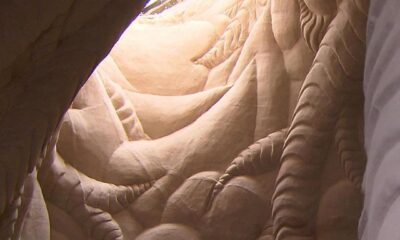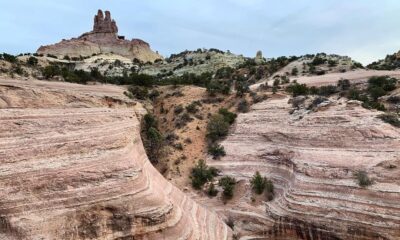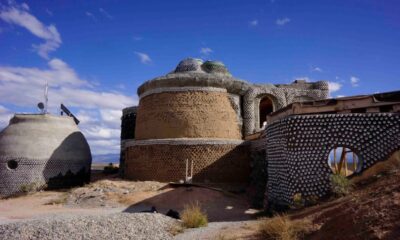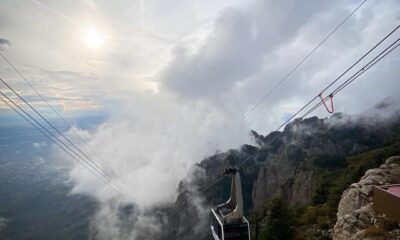New Mexico
Hike On These 9 Rare Petroglyph Trails Found Only in New Mexico
When we think of hiking, we often envision escaping into nature, but New Mexico’s petroglyph trails offer a unique journey through time. These paths provide panoramic views and lead to fascinating ancient rock art, allowing us to glimpse how people from the past viewed our world. Let’s walk back in time and study rock art, discovering the wonders of these ancient petroglyphs in New Mexico.
Rinconada Canyon, Petroglyph National Monument

Credit: https://www.instagram.com/p/CstwZ03JV5G/
Rinconada Canyon within the Petroglyph National Monument boasts one of the largest petroglyph collections in North America. The 2.2-mile trail showcases 300 pieces of rock art, ranging from symbols to intricate figures. The hike is considered as easy to moderate and starts at Unser Boulevard NW and St. Joseph Avenue in Albuquerque.
Piedras Marcadas Canyon, Petroglyph National Monument

Credit: https://www.instagram.com/p/CQD21o1h1p_/
This petroglyph hike allows leashed pets and features around 400 petroglyphs along a 1.5-mile round trip, making it accessible for all explorers. Trailhead is at Jill Patricia Street in Albuquerque, off Golf Course Road.
Boca Negra, Petroglyph National Monument

Credit: https://www.instagram.com/p/CMqu_ScDhF7/
Boca Negra offers three short trails, with the Mesa Point Trail being a standout choice. This route leads to a hill adorned with petroglyphs and offers stunning views along the way. Located at 6001 Unser Boulevard NW, Albuquerque.
Three Rivers Petroglyph Site, Tularosa

Credit: https://www.instagram.com/p/C4eYmHyPMbC/
With an astounding 21,000 petroglyphs scattered across the valley, this site showcases rock art from the Jornada Mogollon culture. Two short trails totaling about a mile lead to a diverse array of ancient art at 455 Three Rivers Road in Tularosa.
Petroglyph Trail, Chaco Culture National Historical Park

Credit: https://www.instagram.com/p/CkL9Alqp3PN/
The 0.25-mile Petroglyph Trail connects Pueblo Bonito and Chetro Ketl, complementing the exploration of these iconic sites at Chaco Culture National Historical Park.
Una Vida, Chaco Culture National Historical Park

Credit: https://www.instagram.com/p/B1pX6RGgc1g/
A roughly one-mile hike at Chaco leads to Una Vida’s ancient ruins, with a petroglyph panel awaiting further exploration. The trailhead is near the visitor center, offering a glimpse into Chaco’s rich history.
Main Pueblo Loop Trail, Bandelier National Monument

Credit: https://www.instagram.com/p/CklPfL-MLeH/
This 1.2-mile trail at Bandelier National Monument highlights the monument’s key features, including the Long House with numerous petroglyphs.
Tsankawi, Bandelier National Monument

Credit: https://www.instagram.com/p/CJXsQ2hA0Ep/
Separate from the main part of Bandelier, Tsankawi offers a 1.5-mile round-trip hike showcasing petroglyphs, kivas, and village remnants. Ladders add to the adventure.
La Cieneguilla, Santa Fe

Credit: https://www.instagram.com/p/CH1D4sYAORe/
A hidden gem near Santa Fe Airport, this 1.3-mile hike leads to petroglyphs and stunning mountain views. It is accessible via Airport Road in Santa Fe.
Must Know Info Before You Plan Your Trip
Here are some visitor tips for exploring New Mexico’s petroglyph trails:
1. Wear Appropriate Gear: Wear comfortable, weather-appropriate clothing and sturdy hiking shoes suitable for rocky terrain.
2. Bring Ample Water: Carry plenty of water to stay hydrated, especially as many of these trails lack shade.
3. Apply Sun Protection: Use sunscreen, wear a hat, and consider sunglasses to protect yourself from the sun’s glare, as many trails are exposed.
4. Pack Essentials: Carry essentials like a trail map, snacks, a first-aid kit, and any necessary medications.
5. Respect the Petroglyphs: Do not touch or deface the petroglyphs. Leave them undisturbed to preserve these ancient artworks for future generations.
6. Follow Trail Etiquette: Stay on designated trails, respect wildlife, and avoid littering.
7. Check Trail Conditions: Check for trail closures and weather updates before heading out.
8. Pet Regulations: If hiking with pets, ensure they are leashed where required and follow pet guidelines for each trail.
9. Be Prepared for Terrain: Some trails may involve rocky or uneven terrain, stairs, ladders, or moderate climbs. Be prepared for varying levels of difficulty.
10. Start Early: Begin your hike early in the day to avoid crowds and the midday heat, especially during warmer months.
Significance of Petroglyphs
Petroglyphs served as crucial means of communication and storytelling for indigenous peoples worldwide. In the context of New Mexico, these ancient rock art carvings hold immense significance as they depict narratives of cultural traditions, historical events, spiritual beliefs, and connections to the land. The symbols and figures found in petroglyphs often convey a deep reverence for nature, wildlife, celestial bodies, and ancestral knowledge. They serve as visual records that allow us to glimpse into the past and understand how indigenous communities viewed and interacted with their environment.
Local Indigenous Perspectives
Insights from local indigenous communities provide invaluable perspectives on the significance of petroglyphs and their cultural heritage. Elders, historians, and cultural experts within these communities offer unique interpretations and stories related to the petroglyphs, enriching our understanding of their meanings and contexts. Indigenous perspectives highlight the deep spiritual connections, traditional knowledge, and historical narratives embedded in these ancient artworks. Collaborative efforts between researchers, archaeologists, and indigenous communities foster mutual respect, cultural exchange, and shared stewardship of New Mexico’s petroglyphs.
Preservation Efforts
Efforts to preserve and protect New Mexico’s ancient petroglyphs are ongoing and crucial for maintaining their historical and cultural value. Various organizations, government agencies, and local communities collaborate on initiatives aimed at conserving these priceless treasures. Preservation efforts include measures to prevent vandalism, erosion, weathering, and unauthorized access to sensitive sites. Conservation techniques such as monitoring, documentation, physical protection, and public education campaigns are employed to ensure that these petroglyphs remain intact for future generations to appreciate and study.
Let’s preserve and appreciate these ancient treasures as we explore New Mexico’s fascinating petroglyph trails.

 New Mexico4 days ago
New Mexico4 days agoCheck Out these Hand-Carved Sand Caves Made 100% By Hand Found Only in New Mexico

 New Mexico7 days ago
New Mexico7 days agoExplore New Mexico’s Dinosaur-Era Red Rock Formation Unseen Even by Many Locals

 New Mexico6 days ago
New Mexico6 days agoVisit these Extraordinary Eco-Spaceships Found Only in New Mexico

 New Mexico22 hours ago
New Mexico22 hours agoCheck Out this Abandoned Health Resort in New Mexico that has an Eerie History

 California6 days ago
California6 days agoHere are 10 Things People from California Do That Seem Insane To Everyone Else

 New Mexico7 days ago
New Mexico7 days agoTake This Aerial Tramway in New Mexico to Unveil Nature’s Hidden Beauty

 Florida6 days ago
Florida6 days ago15 Expressions You’ll Only Understand if You’re From Florida

 Washington5 days ago
Washington5 days agoHere are 10 Things People from Washington Do That Seem Insane To Everyone Else










